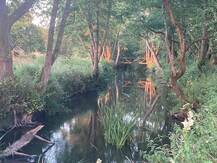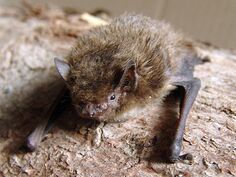 Photo: Dick Budden, Sunset on the Nadder 18 July 2021 Photo: Dick Budden, Sunset on the Nadder 18 July 2021 We know from the survey undertaken last year further up the Nadder near Weaveland Farm, that this area is phenomenally popular with bats. Then, 5297 passes were recorded from a total of 10 identified species, over a month. This year, Peter G Thompson (who gave us our first Zoom talk last Autumn) placed a static bat monitor on one of the bridges over the Nadder in Dick Budden's patch for five nights in early July. It recorded 10,000 hits, i.e. 2,000 each night on average, with 13 different bat species = 75% of all the species resident in UK! The species were: Barbastelle bat (Barbastella barbastellus) Brandt’s bat (Myotis brandtii) Brown long-eared bat (Plecotus auritus) Common pipistrelle (Pipistrellus pipistrellus) Daubenton’s bat (Myotis daubentonii) Greater horseshoe bat (Rhinolophus ferrumequinum) Leisler’s bat (Nyctalus leisleri) Lesser horseshoe bat (Rhinolophus hipposideros) Natterer’s bat (Myotis nattereri) Noctule (Nyctalus noctula) Serotine (Eptesicus serotinus) Soprano pipistrelle (Pipistrellus pygmaeus) Whiskered bat (Myotis mystacinus) The survey on this stretch of the Nadder is part of a programme Peter is working on to map the bat population along the Nadder from Tisbury all the way to Barford St Martin by the end of this summer. Hopefully we’ll get him to share with us the results in due course.  Pipistrellus nathusii Mnolf, CC BY-SA 3.0, via Wikimedia Commons Pipistrellus nathusii Mnolf, CC BY-SA 3.0, via Wikimedia Commons Meanwhile, these tiny creatures do sometimes live the most extraordinary lives. The Guardian reported that a Nathusius's Pipistrelle (we have only the Common kind) weighting just 8g (I don't think my scales would even weigh that little), flew 1,200 miles - and ended up being killed by a cat. Life isn't fair, for bats any more than it is for humans. Comments are closed.
|
Photo: Avocets (Izzy Fry)
The headers display photos taken by our members. Do get in touch via the Contact Form if you'd like to submit a photo for selection.
Archives
May 2024
Categories
All
|

 RSS Feed
RSS Feed